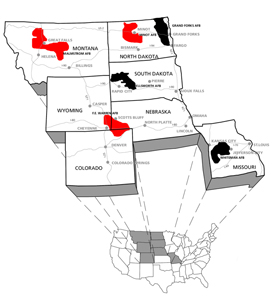MISSILE SILOS

View larger
Across the Great Plains, from northern Colorado into western Nebraska and throughout Wyoming, North Dakota, and Montana, are the missile fields of the United States nuclear program. Each of the three Strategic Missile Wings at Malmstrom Air Force Base, Montana, F. E. Warren Air Force Base, Wyoming, and Minot Air Force Base, North Dakota, has oversight and control over the missile force, which is comprised of Minuteman III and Peacekeeper missiles. Each of these missiles is stored, ready to launch, in its own hardened launch facility, commonly called a missile silo.
Missile silos are scattered across such vast expanses so that potential adversaries would have to target each missile individually. For instance, the missile field of F. E. Warren Air Force Base includes portions of western Nebraska, northern Colorado, and eastern Wyoming, an area of more than 12,000 square miles. A chain-link fence, barbed wire, and an array of motion-detection devices enclose each silo. Armed guards routinely inspect each site and respond immediately to any attempted unauthorized access. Visible from the surface is each silo's 110-ton blast door, which looks like a well-guarded slab of concrete. Stored below is the missile that, in a true launch situation, would emerge after the door was blasted off the silo opening by explosive charges. The missiles are stored underground to provide protection from the elements and from attack. Not much of a silo is visible from above, but the depth of a missile silo that accommodates either a Peacekeeper or Minuteman missile exceeds 100 feet.
See also ARCHITECTURE: Cold War Architecture / WAR: Cold War.
Steve Slate United States Air Force Academy
Previous: Mad Pioneer Women | Contents | Next: Mount Rushmore National Memorial
XML: egp.ii.042.xml
